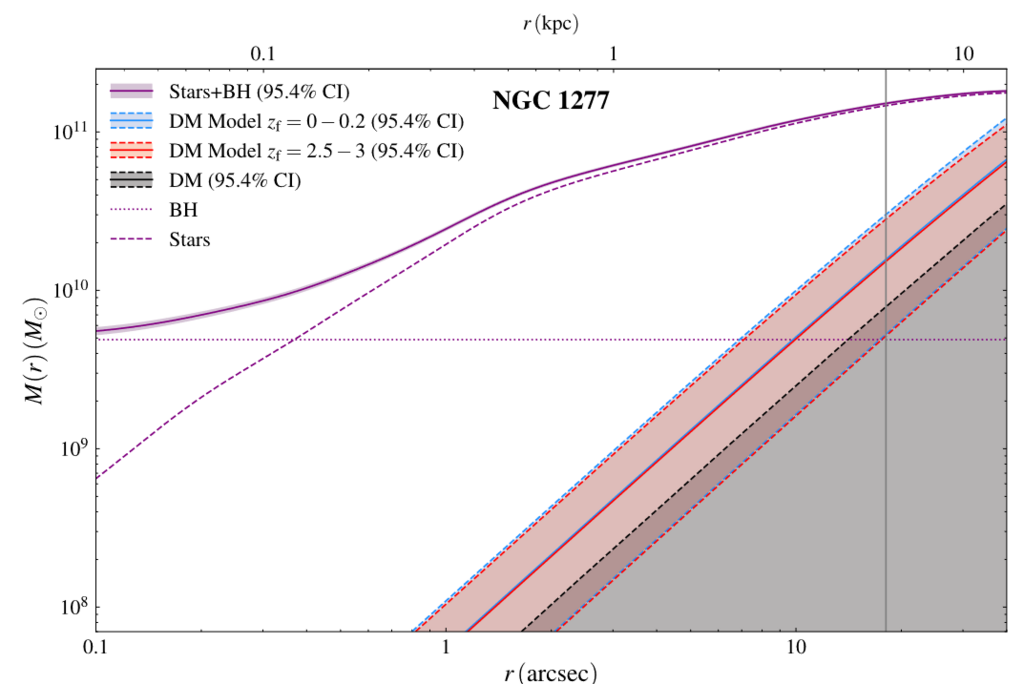Large Relic Galaxy Found to be Dark Matter Deficient

Relic galaxies, a rare subset of galaxies, stand as cosmic anomalies, seemingly "frozen" in time. They are believed to retain their early structures and properties from a much younger universe, bypassing the typical two-step formation process most massive elliptical galaxies undergo. This process usually involves the rapid growth of a compact core, followed by the accumulation of an extended envelope through mergers. Yet, relic galaxies appear to have missed this latter accretion phase, retaining their original form.
Among these cosmic relics, the massive galaxy NGC 1277 presents an intriguing case. This galaxy has a redshift of Z ≈ 2, meaning that the galaxy has remained unchanged since the visible snapshot, approximately 3.08 billion years after the big bang. In stark contrast to the Λ cold dark matter (ΛCDM) cosmological model's prediction, NGC 1277 appears deficient in dark matter. For galaxies of mass around 1.5×1011M⊙, the model anticipates dark matter to contribute roughly 15% of the dynamical mass within one effective radius and 60% within five.
Sébastien Comerón et al. published models of NGC 1277 that challenge these figures. They proposed that within a radius of 6kpc (corresponding to 5Re), the dark matter fraction is merely 5%.

Data for this study was gathered using the George and Cynthia Mitchell Spectrograph (GCMS), an integral field spectrograph at the 2.7 m Harlan J. Smith telescope at the McDonald Observatory. This data significantly improved upon previous data, providing a wider coverage of the galaxy, which is crucial for exploring the outskirts of the galaxy where dark matter was expected to contribute most to the mass budget.
The study used this data to construct kinematic mass maps for the galaxy. To establish detailed dynamical models of the supermassive black hole and the dark matter halo, the researchers employed the Jeans Anisotropic Modelling package. The same procedures were subsequently applied to a neighbouring galaxy, NGC 1278. Remarkably, the investigation found that within a 6 kpc radius, approximately 14% of NGC 1278's mass could be attributed to dark matter. This result aligns with the expectations posited by the Lambda Cold Dark Matter (ΛCDM) model.
A possible explanation for this discrepancy may already have been found, as has been posited within Flores-Freitas et al, published in 2022. According to models derived from the TNG50 simulation, which is a largescale magnetohydrodynamical simulation for galaxy formation, it is proposed that galaxies may be stripped of their dark matter during interactions within their clusters. It remains entirely possible that NGC 1277 is an observation of this phenomenon.
Alternatively, the study considers the potential role of the Milgromian regime in this scenario. While Milgrom’s modifications to Newtonian mechanics have yet to be conclusively confirmed, the team mention that its appropriate application may also account for the observed deficiency. This marks another of a series of unexplainable phenomena that may be accounted for by these alternative formulations.
These findings are a significant milestone in astrophysics, calling into question prevailing theories on dark matter distribution. The study highlights the nuanced challenges that arise in estimating black hole masses, especially when utilizing low angular resolution data. Promisingly, the use of images with JWST resolution, combined with advanced deconvolution methods, may offer a pathway to more accurate determinations in the future. As the study suggests, thorough testing with mock simulated data will be pivotal in verifying these techniques.
Journal Source: S. Camerón et al, The massive relic galaxy NGC 1277 is dark matter deficient, Astronomy and Astrophysics, Vol. 675, No. A143, 2023, https://doi.org/10.1051/0004-6361/202346291
